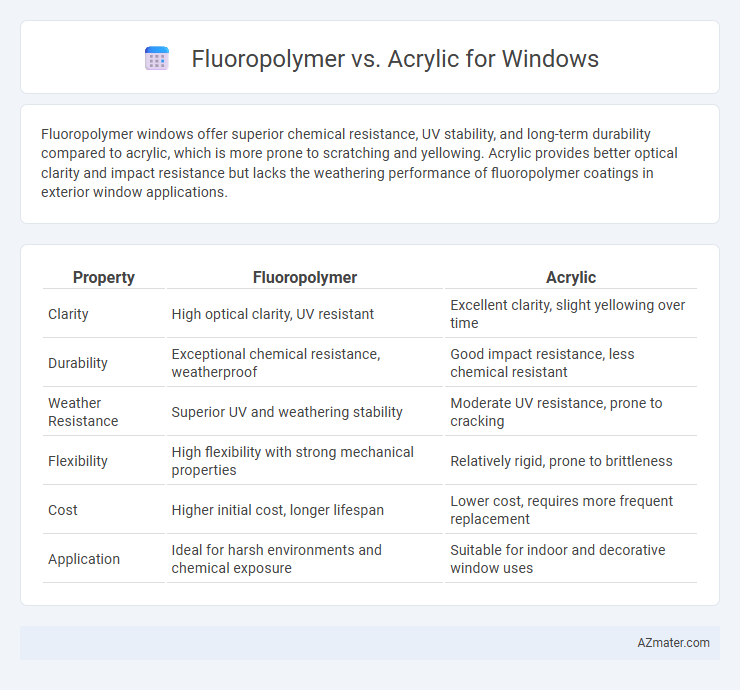Fluoropolymer windows offer superior chemical resistance, UV stability, and long-term durability compared to acrylic, which is more prone to scratching and yellowing. Acrylic provides better optical clarity and impact resistance but lacks the weathering performance of fluoropolymer coatings in exterior window applications.
Table of Comparison
| Property | Fluoropolymer | Acrylic |
|---|---|---|
| Clarity | High optical clarity, UV resistant | Excellent clarity, slight yellowing over time |
| Durability | Exceptional chemical resistance, weatherproof | Good impact resistance, less chemical resistant |
| Weather Resistance | Superior UV and weathering stability | Moderate UV resistance, prone to cracking |
| Flexibility | High flexibility with strong mechanical properties | Relatively rigid, prone to brittleness |
| Cost | Higher initial cost, longer lifespan | Lower cost, requires more frequent replacement |
| Application | Ideal for harsh environments and chemical exposure | Suitable for indoor and decorative window uses |
Introduction to Fluoropolymer and Acrylic Coatings for Windows
Fluoropolymer coatings for windows offer exceptional durability, UV resistance, and weatherability, making them ideal for long-lasting exterior applications. Acrylic coatings provide excellent clarity, color retention, and adhesion, often used for enhancing aesthetic appeal and moderate protection. Both materials improve window performance, but fluoropolymers excel in chemical resistance, while acrylics are favored for cost-effective finishing and ease of application.
Composition and Chemical Properties
Fluoropolymer windows are composed of polymers containing fluorine atoms, offering exceptional chemical resistance, UV stability, and low surface energy, which prevents dirt accumulation and degradation from environmental exposure. Acrylic windows, made from polymethyl methacrylate (PMMA), provide excellent optical clarity and moderate chemical resistance but are more susceptible to scratching and UV-induced yellowing over time. The fluoropolymer's strong carbon-fluorine bonds result in superior durability and weatherability compared to acrylic's carbon-carbon and carbon-oxygen bonds, making fluoropolymers ideal for harsh or long-term outdoor applications.
Weather Resistance and Durability
Fluoropolymer coatings exhibit superior weather resistance and durability compared to acrylics, offering excellent protection against UV radiation, moisture, and extreme temperature fluctuations. Acrylic coatings tend to degrade faster under prolonged exposure to harsh weather, leading to chalking, cracking, and color fading. Fluoropolymers maintain structural integrity and color stability for decades, making them ideal for long-term exterior window applications.
UV Protection and Fading Performance
Fluoropolymer coatings offer superior UV protection compared to acrylic, effectively blocking harmful ultraviolet rays and preventing window material degradation. Their chemical stability and resistance to weathering result in exceptional long-term fading performance, maintaining clarity and color retention over time. Acrylic coatings, while more affordable, tend to yellow and fade faster under continuous UV exposure, making them less durable for high sun-exposure applications.
Aesthetic Options and Color Retention
Fluoropolymer coatings offer superior color retention and UV resistance compared to acrylic, maintaining vibrant hues and preventing yellowing over decades. Acrylic finishes provide a wider range of aesthetic options with customizable textures and gloss levels, but tend to fade and chalk faster under prolonged sun exposure. For long-term aesthetic appeal, fluoropolymer is preferred in harsh climates, while acrylic suits applications where immediate design versatility is prioritized.
Maintenance and Cleaning Requirements
Fluoropolymer windows offer superior resistance to dirt, stains, and UV degradation, resulting in less frequent cleaning and minimal maintenance compared to acrylic. Acrylic windows tend to attract dust and grime more easily and may require more regular cleaning with non-abrasive solutions to avoid surface scratches and discoloration. The durable, non-stick surface of fluoropolymer materials significantly reduces labor time and cleaning costs over the product's lifespan.
Environmental Impact and Sustainability
Fluoropolymer coatings for windows offer exceptional durability and resistance to weathering, reducing the need for frequent replacement and minimizing environmental waste. Acrylic materials, while more biodegradable, often require more frequent maintenance and replacement, increasing their overall environmental footprint. The choice between fluoropolymer and acrylic windows hinges on balancing long-term sustainability benefits of durability against the biodegradability of materials.
Cost Analysis and Long-Term Value
Fluoropolymer window coatings generally incur higher initial costs than acrylic options due to advanced chemical resistance and durability. Over time, fluoropolymers provide superior weather resistance, UV stability, and reduced maintenance expenses, translating into greater long-term value despite the upfront investment. Acrylic coatings, while more affordable initially, tend to degrade faster under environmental stress, leading to frequent replacements and higher cumulative costs.
Application Methods and Compatibility
Fluoropolymers offer superior chemical resistance and durability, making them ideal for industrial and high-performance window coatings applied via spray, dip, or electrostatic methods. Acrylics provide easier application through brush or roll-on techniques and are compatible with a wider range of substrates, offering flexibility for residential and commercial windows. Compatibility with surface primers varies: fluoropolymers require specialized primers for adhesion, while acrylics often bond well with standard primers, influencing project efficiency and lifespan.
Choosing the Right Coating for Your Windows
Fluoropolymer coatings offer superior weather resistance, UV protection, and durability, making them ideal for windows exposed to harsh environmental conditions. Acrylic coatings provide excellent clarity and color retention, suitable for interior windows or areas with moderate exposure. Selecting the right coating depends on factors like climate, maintenance requirements, and long-term performance needs to ensure optimal window protection and aesthetic appeal.

Infographic: Fluoropolymer vs Acrylic for Window
 azmater.com
azmater.com